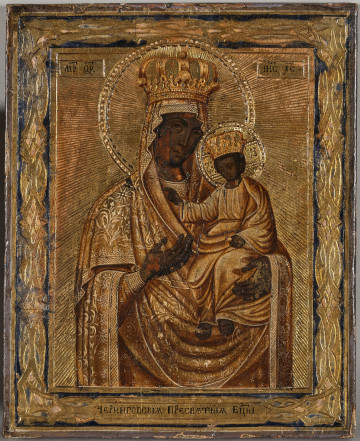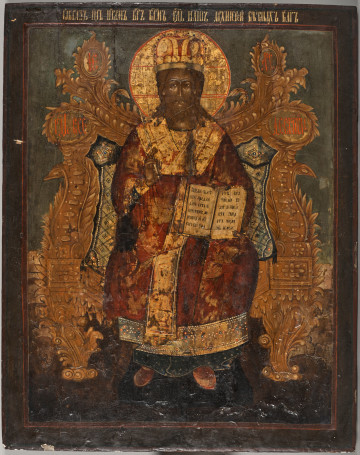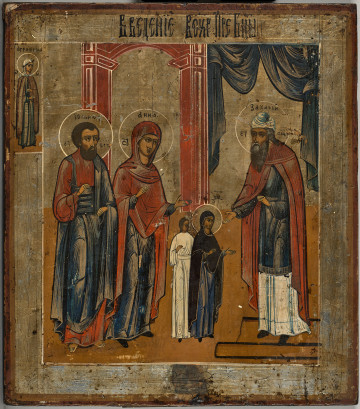
The Mother of God of Hodigitria
19th (?) century
Castle Museum in Łańcut
Part of the collection: Ikony
In the consciousness of the modern man, there is a belief that an icon is a religious image painted with tempera on a wooden panel. Indeed, in the Eastern Christian religious art tradition, in the lands of Rus, among others, one of the most widespread painting methods for centuries was the technique of painting with tempera on a wooden base. However, going back to the Byzantine origins of painting, it is worth remembering that the word 'icon', borrowed from the Greek 'eikon' means 'an image', 'a picture' in general. In Christian art, it is a religious image. Since the early centuries of Christianity, various techniques of painting on various types of surfaces had been developing. One of the oldest ones was the encaustic painting technique using wax. Pictures were also painted on the walls of places of worship, creating series closely connected with the liturgy. The mosaic, characteristic of Byzantine art, is also an icon. On a smaller scale, when making holy images, one used casting techniques, goldsmithing, and enamelling. Sacred images were illuminated on the pages of manuscripts, block printed, made from ivory, and embroidered. In Muscovite Rus, church councils gave detailed guidelines and recommendations on the making of icons. Templates were also useful. Over time, as was the case in the sphere of European art earlier, the oil painting technique started being used on wooden canvas boards. Icons on cloth canvases were painted with oil paints, which keep their elasticity for a longer time. This can be seen on the displayed icon, where the traditional in Eastern iconography figures of Christ Pantocrator with his right hand raised in a blessing, Virgin Hodegetria - the guide pointing the way to the Son-Saviour, and the especially venerated in Rus saints Nicholas the Wonderworker and Great Martyr Barbara were treated according to the convention of Western European painting. Teresa Bagińska-Żurawska https://orcid.org/0000-0002-9243-3967
Dimensions
height: 75 cm, width: 111 cm
Object type
Icons
Technique
oil
Material
oil-based paint, canvas
Origin / acquisition method
decyzja administracyjna
Creation time / dating
Creation / finding place
Owner
Castle Museum in Łańcut
Identification number
Location / status

19th (?) century
Castle Museum in Łańcut

1800 — 1850
Castle Museum in Łańcut

1800 — 1899
Castle Museum in Łańcut
DISCOVER this TOPIC
Museum of King Jan III's Palace at Wilanów
DISCOVER this PATH
Educational path